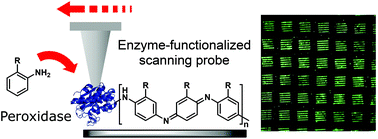Our official English website, www.x-mol.net, welcomes your
feedback! (Note: you will need to create a separate account there.)
Parallelized biocatalytic scanning probe lithography for the additive fabrication of conjugated polymer structures†
Nanoscale ( IF 5.8 ) Pub Date : 2018-04-04 00:00:00 , DOI: 10.1039/c8nr01283k Joseph Hosford 1, 2, 3, 4 , Morgane Valles 1, 2, 3, 4 , Florian W. Krainer 5, 6, 7, 8, 9 , Anton Glieder 5, 6, 7, 8, 9 , Lu Shin Wong 1, 2, 3, 4
Nanoscale ( IF 5.8 ) Pub Date : 2018-04-04 00:00:00 , DOI: 10.1039/c8nr01283k Joseph Hosford 1, 2, 3, 4 , Morgane Valles 1, 2, 3, 4 , Florian W. Krainer 5, 6, 7, 8, 9 , Anton Glieder 5, 6, 7, 8, 9 , Lu Shin Wong 1, 2, 3, 4
Affiliation

|
Scanning probe lithography (SPL) offers a more accessible alternative to conventional photolithography as a route to surface nanofabrication. In principle, the synthetic scope of SPL could be greatly enhanced by combining the precision of scanning probe systems with the chemoselectivity offered by biocatalysis. This report describes the development of multiplexed SPL employing probes functionalized with horseradish peroxidase, and its subsequent use for the constructive fabrication of polyaniline features on both silicon oxide and gold substrates. This polymer is of particular interest due to its potential applications in organic electronics, but its use is hindered by its poor processability, which could be circumvented by the direct in situ synthesis at the desired locations. Using parallelized arrays of probes, the lithography of polymer features over 1 cm2 areas was achieved with individual feature widths as small as 162 ± 24 nm. The nature of the deposited materials was confirmed by Raman spectroscopy, and it was further shown that the features could be chemically derivatized postlithographically by Huisgen [2 + 3] “click” chemistry, when 2-propargyloxyaniline was used as the monomer in the initial lithography step.
中文翻译:

平行生物催化扫描探针光刻技术用于共轭聚合物结构的增材制造†
扫描探针光刻(SPL)提供了比常规光刻更易于访问的替代方法,可以作为表面纳米加工的一种途径。原则上,将扫描探针系统的精度与生物催化提供的化学选择性结合起来,可以大大提高SPL的合成范围。该报告描述了采用辣根过氧化物酶功能化的探针的多重SPL的开发,及其随后在氧化硅和金基底上用于聚苯胺结构的结构性制造的用途。这种聚合物因其在有机电子领域的潜在应用而特别受关注,但其可加工性较差而无法使用,可通过直接就地加工来避免这种聚合物的使用。在所需位置进行合成。使用平行的探针阵列,可以在1 cm 2的面积上实现聚合物特征的光刻,其单个特征宽度小至162±24 nm。通过拉曼光谱法证实了沉积材料的性质,并且进一步表明,当在初始光刻中使用2-炔丙基氧基苯胺作为单体时,可以通过Huisgen [2 + 3]“点击”化学方法在光刻后对这些特征进行化学衍生化。步。
更新日期:2018-04-04
中文翻译:

平行生物催化扫描探针光刻技术用于共轭聚合物结构的增材制造†
扫描探针光刻(SPL)提供了比常规光刻更易于访问的替代方法,可以作为表面纳米加工的一种途径。原则上,将扫描探针系统的精度与生物催化提供的化学选择性结合起来,可以大大提高SPL的合成范围。该报告描述了采用辣根过氧化物酶功能化的探针的多重SPL的开发,及其随后在氧化硅和金基底上用于聚苯胺结构的结构性制造的用途。这种聚合物因其在有机电子领域的潜在应用而特别受关注,但其可加工性较差而无法使用,可通过直接就地加工来避免这种聚合物的使用。在所需位置进行合成。使用平行的探针阵列,可以在1 cm 2的面积上实现聚合物特征的光刻,其单个特征宽度小至162±24 nm。通过拉曼光谱法证实了沉积材料的性质,并且进一步表明,当在初始光刻中使用2-炔丙基氧基苯胺作为单体时,可以通过Huisgen [2 + 3]“点击”化学方法在光刻后对这些特征进行化学衍生化。步。











































 京公网安备 11010802027423号
京公网安备 11010802027423号